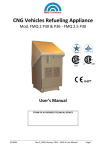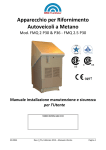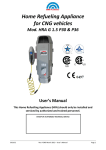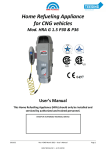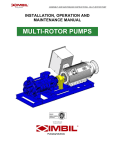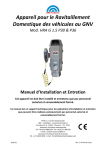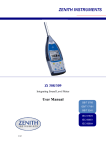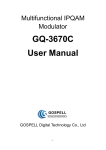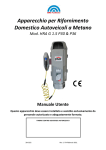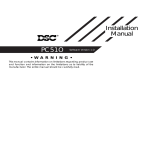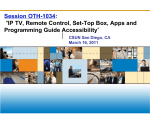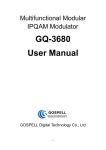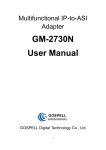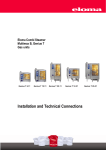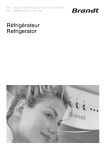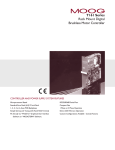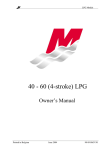Download Installation Maintenance and Safety
Transcript
Home Refueling Appliance for CNG vehicles Mod. HRA G 1.5 P30 & P36 Installation Maintenance and Safety Manual This Home Refueling Appliance (HRA) should only be installed and serviced by authorized and trained personnel. 39.0151 Rev.4 ENG March 2013 – Installation Maintenance and Safety Manual WWW.TEESING.COM | +31 70 4130700 Page 1 BRC - FuelMaker - M.T.M. S.r.l. U. Via Industria, 6 - 12062 - Cherasco - CN - ITALY International Technical Assistance Tel. +39.0172.48.68.628 0172.48.68.363 - 0172.48.68.623.- Fax +39.0172.486.630 e-mail: [email protected] - www.brcfuelmaker.it North America – Canada Technical Assistance Tel. +1.705.341.19.23 e-mail: [email protected] 39.0151 Rev.4 ENG March 2013 – Installation Maintenance and Safety Manual WWW.TEESING.COM | +31 70 4130700 Page 2 SUMMARY 1. SAFETY INSTRUCTIONS ...................................................................................................................................... 4 2. INTRODUCTION ................................................................................................................................................. 5 3. PHILL MODELS ................................................................................................................................................... 5 4. TECHNICAL SPECIFICATIONS .............................................................................................................................. 6 5. INSTALLATION INSTRUCTIONS ........................................................................................................................... 6 5.1 5.2 5.3 5.4 6. GENERAL INFORMATION ...................................................................................................................................... 6 APPLIANCE LOCATION .......................................................................................................................................... 7 HRA INSTALLATION ............................................................................................................................................. 10 EXTERNAL GAS SENSOR INSTALLATION .............................................................................................................. 14 COMMISSIONING .............................................................................................................................................14 6.1 6.2 7. INITIAL START-UP ................................................................................................................................................ 14 INSTRUCTIONS FOR FINAL USER ......................................................................................................................... 15 FUNCTIONS OF USER’S CONTROL PANEL ..........................................................................................................15 7.1 DISPLAY ERRORS ................................................................................................................................................. 16 8. MAINTENANCE INSTRUCTIONS .........................................................................................................................22 9. HRA REMOVAL .................................................................................................................................................22 10. SAFETY AND DIAGNOSTIC FUNCTIONS .............................................................................................................23 10.1 10.2 SAFETY FUNCTIONS........................................................................................................................................ 23 DIAGNOSTIC FUNCTIONS ............................................................................................................................... 26 11. RELIABILITY TECHNICAL DATA ..........................................................................................................................38 12. DISPOSAL..........................................................................................................................................................39 13. WARRANTY CERTIFICATE ..................................................................................................................................40 14. CE CONFORMITY DECLARATION .......................................................................................................................41 15. CERTIFICATE SIL 1 .............................................................................................................................................43 TABLES SUMMARY Tabella 1 - Phill models ....................................................................................................................................................... 5 Tabella 2 - Technical Specification ...................................................................................................................................... 6 Tabella 3 - Stopping Pressure compared with Ambient Temperature ............................................................................ 14 Tabella 4 - Working Hours codes ...................................................................................................................................... 16 Table 5 – Error diagnostics................................................................................................................................................ 17 Tabella 6 – Safety functions .............................................................................................................................................. 23 Table 7 – Appliance response ........................................................................................................................................... 24 Table 8 – Appliance response time ................................................................................................................................... 25 Table 9 - Appliance response ............................................................................................................................................ 26 Table 10 – System response time ..................................................................................................................................... 34 Table 11 – Failure Probability ........................................................................................................................................... 38 Tabella 12 - Diagnostic Coverage ...................................................................................................................................... 38 Table 13 - Safe Failure Fraction ........................................................................................................................................ 38 39.0151 Rev.4 ENG March 2013 – Installation Maintenance and Safety Manual WWW.TEESING.COM | +31 70 4130700 Page 3 1. SAFETY INSTRUCTIONS • COMPONENTS ARE NON REPLACEABLE BY USER USERs SHOULD NOT CARRY OUT ANY MAINTENANCE ON INTERNAL COMPONENTS. Internal components should only be maintained and overhauled at BRC FuelMaker’s premises or by authorized dealers. Do not open or tamper with modules or the warranty will be invalidated; tampering with or opening modules could be dangerous and cause damage to the compressor and cause serious injury or even death. • READ CAREFULLY BEFORE INSTALLATION HRAs should only be installed by trained and personnel authorized by BRC FuelMaker. Please read carefully the manual provided before installation and use. If you have any questions or concerns during installation, please contact BRC FuelMaker Technical Support. • LOCATION OF HOME REFUELLING APPLIANCE (HRA) HRAs can be installed both indoors (Garage) and outdoors in safe and protected areas as per installation instructions and local jurisdictional codes. The HRA and vehicle have to be located in the same ambient temperature during the refuelling operation to ensure correct temperature compensation. See Table 2 for temperature compensated maximum fuelling pressures. • REFUELING APPLIANCE FOR CNG (Compressed Natural Gas) VEHICLES ONLY Do not use HRA for any other purpose or it may results in serious injury and/or death to and also cause serious damage to structures. Vehicle gas cylinder should be certified for storing CNG at a 3600 psig or 250 Bar pressure or higher. HRA is suitable for residential applications, and all installations must comply with installation manuals and local jurisdictional code requirements. • REFUELING INSTRUCTIONS Do not refuel with engine turned on and be sure that any possible ignition source is absent. Do not smoke or expose to open flames during refuelling. • IF YOU SMELL GAS Open all windows and doors in the location of the HRA if the unit is installed indoors. Immediately close the manual valve on natural gas supply line; and, if possible, the valve on the vehicle cylinder. Switch off any possible ignition sources and contact an Authorized Service Centre. • REFUELING HOSE The refuelling hose must be protected from damage and abrasion. After refuelling your car, ensure that the refuelling nozzle is returned to its’ holder. In case of hose and connector abrasions or wear, contact your Authorized Technical Centre for service. WARNING : DO NOT USE SOLVENT OR AGGRESSIVE CHEMICAL AGENTS FOR CLEANING THE OUTSIDE. USE DETERGENTS OR DOMESTIC GENTLE SOAP. 39.0151 Rev.4 ENG March 2013 – Installation Maintenance and Safety Manual WWW.TEESING.COM | +31 70 4130700 Page 4 2. INTRODUCTION HRA has been developed for both indoors (Garage) and outdoors installation, for compressing Natural Gas for vehicle use. Model P30 is designed to refuel at a pressure of 207 bar/3,000 psi at 20° C/68° F (ambient temperature) with a 3 Nominal Flow of 1,3 sm /h at 50 Hz (1.01 scfm-0.5 GGE/h at 60 Hz). Model P36 is designed to refuel at a pressure of 248 bar/3,600 psi at 15° C/59° F (ambient temperature) with a 3 Nominal Flow of 1,3 sm /h at 50 Hz (1.01 scfm-0.5 GGE/h at 60 Hz). A HRA is equipped with Internal Gas Sensor/Air Flow Switch and Internal Dryer. 3. PHILL MODELS Tabella 1 - Phill models WARNING Phill models without the gas dryer (Smart and Basic) are available but they can be used only if the gas is already dried. We recommend to use gas with dew point at the maximum delivery pressure of 5°C lower than the minimum ambient temperature. WARNING In case of outdoor installation with adequate ventilation the Phill Smart use without the internal gas detector is allowed The Phill software is designed for the constant monitoring of the all compressor components. The software checks for the pressure increasing as well as the maximum filling pressure compensation in reference to the ambient temperature in order to avoid overpressures due to external temperature rising after filling. The automatic compensation system is determined by the temperature temperature sensor installed on the main board (function activated by the manufacturer). The Phill is air cooled and admits operating temperature between -40°C/-40°F and +45°C/113°F. The Phill ventilation system operates through a fan located in the compressor lower lower side. The cooling air inlet is equipped with a grid while the exhaust is located in the compressor upper side or rear side. Start, stop, and monitoring are performed by the User Control Panel. 39.0151 Rev.4 ENG March 2013 – Installation Maintenance and Safety Manual WWW.TEESING.COM | +31 70 4130700 Page 5 4. TECHNICAL SPECIFICATIONS GAS CIRCUIT Max Filling Pressure 207 bar (3000 psig) at 20° C (68°F) ambient 248 bar (3600 psig) at 15° C (59°F)ambient Min Inlet Pressure 17 mbar (7” w.c.) Max Inlet Pressure 35 mbar (14” w.c.) Nominal Flow 1.3 sm3/h a 20°C - 0.017 bar inlet 1.01 scfm/0.5 GGE/h @ 68°F 7”w.c. WIRING CIRCUIT Electrical Supply 220-240 Volt AC Single Phase, 50/60 Hz Wiring Circuit Capacity 15 Amp Full Load Amperes 5.5/5.0 Amp Average Consumption 0.85 kWh MECHANICS Dimensions (L x P x A) 762 x 356 x 330 mm/30”x14”x13” Weight 49 Kg/110 lb (packaging included) Noise 40 dBa at 5 mt (16.5 ft) Covering Protection Level IP 24 Operating Temperature from - 40° C to + 46° C (-40°F +115°F) Tabella 2 - Technical Specification 5. INSTALLATION INSTRUCTIONS 5.1 GENERAL INFORMATION Open packaging and verify the condition of the appliance; in case of damage due to transportation immediately contact your local dealer. Ensure that the gas supply and the electrical electrical supply provided correspond to the values indicated on the serial number plate. The Natural Gas connection should be properly done using suitable piping, following installation and testing procedures in accordance with all codes in place by the authorities have jurisdiction. A shut-off valve must be installed on the gas supply line, and with a pressure regulator, if the supply pressure exceeds the max value allowed. Electrical installation should be properly done in accordance with codes determined by the authorities having jurisdiction. Natural Gas must be odorised. The installation of a HRA must comply with all codes determined by the authorities having jurisdiction and those outlined in this manual, in each case the more stringent rule must be followed. The installation of a HRA must comply with all codes determined by the authorities having jurisdiction and those outlined in this manual, in each case the more stringent rule must be followed. - Noise Phill (HRA) soundproof version emits roughly 40 dBA (Hemispheric Field) at a distance of 5 m (16.5 ft). The installer should ensure that no noise regulations are in place by the authorities having jurisdiction. Avoid installing a HRA next to neighbours’ windows or walls that can amplify noise. 39.0151 Rev.4 ENG March 2013 – Installation Maintenance and Safety Manual WWW.TEESING.COM | +31 70 4130700 Page 6 5.2 APPLIANCE LOCATION - Structure requirements HRA weighs roughly 43 Kg (95 lb) and should be installed on a wall or a structure made of non-combustible material able to support min 90 kg (198 lb). The support frame has been designed to reduce noise and vibration transmission to the wall. - Vehicle Refueling Point A HRA must be installed next to the vehicle being refuelled due to an automatic temperature compensation system between outlet and ambient temperature pressures; always consider the max length of refuelling pipe and do not obstruct pedestrian crossing or passages. Choose a location to install a HRA on the basis of the vehicle refuelling point and HRA location, in order to ensure proper operation of the hose breakaway device in the event of a driveaway while the hose is connected (see pict. 2-3-4). - Service Clearances Be sure that Services Clearances are observed (see pict. 1). If Service Clearances cannot be observed, please contact Technical Support. Avoid areas that may allow possible gas accumulation such as overhangs and/or eaves. Avoid areas next to vegetation that could obstruct air grilles or subject to the possible damage due to falling material. Picture 1 – Service Clearances. Picture 2 - Example of installation 39.0151 Picture 3 - Example of installation Rev.4 ENG March 2013 – Installation Maintenance and Safety Manual WWW.TEESING.COM | +31 70 4130700 Page 7 Picture 4 - Installation Distances A breakaway device allows the hose to separate if vehicle drives away while the refuelling hose is still connected. It parts in two to avoid pulling the HRA from its support. In the event of a drive away while the fuelling hose is connected to the vehicle, the fuelling hose connected to the vehicle can only be removed by means of a depressurizing tool. - Impact Protection HRA should be installed 1,5 mt (5 ft) high from the floor or in a location that will ensure that there is no risk of impact from a vehicle or other objects in the vicinity. In some cases such as use of a bigger vehicle, such as VAN or SUV, the HRA may require impact protection such as a bollard (see pict. 5). Always make reference local codes determined by the authorities having jurisdiction. Picture 5 – Impact Protection 39.0151 Rev.4 ENG March 2013 – Installation Maintenance and Safety Manual WWW.TEESING.COM | +31 70 4130700 Page 8 COOLING AIR OUTLET FIXING BRACKET EXT. GAS SENSOR (optional) NOZZLE HOLDER NOZZLE BREAKAWAY EXT. GAS SENSOR AND SERIAL PORT CONNECTION REFUELLING HOSE COOLING AIR INLET INLET AND VENT FITTINGS Picture 6 - Frontal View COOLING AIR INLET VENT FITTING 3/8” GAS INLET FITTING 1/2” SERIAL PORT REFUELLING HOSE EXT. GAS CONNECTOR (optional) Picture 7 – Hard Mount Brackets 39.0151 POWER SUPPLY CABLE Picture 8 - Lower View Rev.4 ENG March 2013 – Installation Maintenance and Safety Manual WWW.TEESING.COM | +31 70 4130700 Page 9 Picture 9 - Support Kit with Soft Mount Vibration and Noise Suppression 5.3 HRA INSTALLATION - Wall installation Determine the best mounting method for the HRA from the preceding information. If it’s equipped with hard mount brackets (see pict. 7), use brackets holes as a template. If it’s equipped with Soft Mount Vibration and Noise Suppression (see pict. 9), the kit will include: No. 2 Support Brackets No. 4 90° Fixing Brackets with Threaded Bush No. 4 Linear Fixing Brackets with Threaded Bush No. 1 Bracket Fixing Device The HRA can be built-in installed between wall studs using the 90° Fixing Brackets or on a flat surface using the Linear Fixing Brackets. Use the template found in the Accessories Box to mark the brackets mounting holes and the Cooling Rear Outlet vent path if necessary. Attach the mounting bracket to the wall, do not tighten screws completely and hang compressor in place on the mounting brackets being careful with to ensure rear hooks ensuring the bracket is correctly mounted. Once mounted correctly and perpendicular, tighten bracket screws and close the mounting lock plate. WARNING: Wall mounts must support the HRA weight and be able to support the unit in the event of a vehicle driveaway while connected to the Phill ensuring that the breakaway on the hose will disconnect safely. Affix nozzle holder to the wall, next to the HRA (see pict. 11). 39.0151 Rev.4 ENG March 2013 – Installation Maintenance and Safety Manual WWW.TEESING.COM | +31 70 4130700 Page 10 Picture 10 - Fixing Screws Picture 11 – Nozzle Holder Mounting Once correctly mounted, open the front cover of the HRA by removing the 5 cover screws. Loosen the three transportation mounts (see pict. 10), but do not remove or attempt to remove these mounts. The screws are mounted to rubber grommets to hold the internal components in place during shipment. WARNING: HRA can be seriously damaged if you do not loosen the 3 transportation screws. In case having to ship the HRA, tighten the 3 transportation screws again before shipping, in order to avoid any damage. - Gas pipe - Inlet 3 HRA should be installed where natural gas network assures a max humidity ratio of 110 mg/m (0.24 lb) (-20° C/-4°F DewPoint). Inlet pressure should not be lower than 17 mBar (7” w.c.) or higher than the one indicated by technical information plate in order to avoid damages to the appliance. Install a pressure regulator on the inlet line if necessary. Gas installation should be properly done by trained and certified personnel. A manual shut-off valve should be installed in an easy-to-access position on gas pipe. In addition a dirt trap and test port need to be installed before the inlet to the HRA unit. Gas inlet pipe is connected to the HRA through the GAS ½” threaded fitting supplied (see pict. 8). In case where inflexible NG supply pipe is fixed to the wall, we suggest using a flex pipe from the pipe to the connection on the HRA to prevent the transmission of vibration and noise to the building. Pipes and connectors should be free from rust, oil, shavings and metallic chards. Liquid or rubber sealant products should not obstruct pipe. In case of supply low pressure (17 mBar - 7” w.c.) pipe should have minimum diameter 1”, if pipe is shorter than 3 mt/10 ft. you can use a ø ¾” pipe. HRA could switch off if other home appliances are working at the same time (e.g. Stove, Heating) on the same supply line. Regulators installed by gas suppliers and for use at the HRA should be equipped with a device to adjust the supply line flow and be tested when all natural gas appliances are running. Check the regulator adjustment by running the HRA compressor and all other home appliances working on the same NG supply line, adjust to ensure that the minimum inlet pressure to the HRA is maintained. Materials, installation and testing procedures should comply with applicable laws in force (e.g. UNI-CIG 7129) 39.0151 Rev.4 ENG March 2013 – Installation Maintenance and Safety Manual WWW.TEESING.COM | +31 70 4130700 Page 11 - Gas pipe - Outlet The HRA refuelling hose should not be replaced by unauthorized personnel not trained by BRC-FuelMaker. Only approved BRC FuelMaker HRA refuelling hoses can be used as use of unauthorized hoses may cause injury, property damage and/or death. - Pressure Relief connection HRA is equipped with a Pressure Relief with an outlet Gas threaded fitting Gas 3/8” (see pict. 9). The Pressure Relief has a cap with a screen insert to prevent intrusion of foreign bodies or ice accumulation. The Pressure Relief discharges gas coming out from Safety Valve set at a max pressure of 3 barg (43.5 psi) situated inside the HRA control module. In the event that natural gas is released, the check valve on the vehicle fuelling receptacle will require service. If HRA needs to be installed in passages, next to windows or next to doors, you will need to connect a pipe to the pressure relief having inside min ø 10 mm. (3/8”) and this pipe run to an area for the safe release of NG, at least 3 mt above the floor or grade. Safety distance from discharge point should be at least of 2,5 mt (8.2 ft) sideways from any possible opening (windows, air inlets or priming sources) and 1 mt (3.3 ft) from below. It is very important that the pressure relief is free from debris and that water cannot enter into the pipe and freeze. Apply cap with the screen at the end of the pressure relief line, or provide similar protection (Stainless Steel net). Please make reference to codes in force by the authorities having jurisdication about the pressure relief pipe position and pipe dimension. - Electrical Supply Connection Electrical installation should be properly done in accordance with the codes in force by the authorities having jurisdiction. The HRA requires a 220-240VAC electric supply line that should be protected from overcurrent installed in a visible and easy-to-access position. Check with the authorities having jurisdiction for minimum requirements and location of a shut off switch. - Cooling Air Ventilation System Connection The HRA is equipped with a Cooling AirVentilation system with a fan located internally in the unit. The air enters from the lower grille (see pict. 8) and exits from either an upper vent (see pict. 7) or a rear vent (see pict. 9), used according to needs. The HRA is normally provided with the rear hole closed and the upper one open. An Soundproof Ventilation Kit can also be purchased (see pict. 12 ). Upper Casing Coupler Modified Coupler Lower Casing Gasket Outlet pipe Picture 12 - Soundproof Ventilation Kit 39.0151 Picture 13 - Casings Rev.4 ENG March 2013 – Installation Maintenance and Safety Manual WWW.TEESING.COM | +31 70 4130700 Page 12 In case of an outdoors installation, install the lower casing (if supplied) and the upper top casing (see pict. 13), following installation instructions. In case of an indoors installation when using the upper exhaust vent, open the frontal covering, insert modified coupler supplied in its suitable housing, fix it with the two screws and close covering again. Install a ø 127 mm (5”) pipe using gasket supplied (see pict. 14) then route the vent piping outside. It is mandatory to install Lower Casing on HRA. Picture 14 - Coupler Picture 15 - External Hood If using the exhaust vent rear hole, the template provide in the accessory kit will allow you to mark out an exit hole (hole ø 170 mm/6.7”) while installing mounting brackets. Remove the rear exhaust cap and secure it onto the upper hole housing. Place coupler on rear hole using the two screws supplied. We suggest to use an external grille as shown in picture in order to avoid air entering into the discharge duct causing defaults or block of HRA (see pictures 15 and 16). Picture 16 - Ventilation with Rear hole 39.0151 Rev.4 ENG March 2013 – Installation Maintenance and Safety Manual WWW.TEESING.COM | +31 70 4130700 Page 13 5.4 EXTERNAL GAS SENSOR INSTALLATION HRA can be equipped with External Gas Sensor (Optional) if necessary. The connector on the cable from the external gas sensor needs to be connected to port situated in the lower side of HRA, next to the serial one (see pict. 8). Once the sensor installed, you need to enable through the software. Connect diagnostic tool HTTP4 (Optional) to the serial . port, following instructions under programming, turn the External Interlock to ON. IMPORTANT: Disconnect electrical supply for at least 1 minute after resetting the programming. Failure to turn the unit off for 1 minute and restarting the HRA will not reset the programming. 6. COMMISSIONING WARNING: HRA should only be commissioned by qualified personnel. Local laws in force could require site and/or installation inspection before starting up. Contact authorities having jurisdication and gas supplier company for further requirements and information. 6.1 INITIAL START-UP - Purge inlet pipes and equipment of air before the initial start-up. • • • • • • • • Switch HRA on. Open manual valve of gas inlet line. Wait for the end of software control cycle (Blinking Green LED becomes fixed). Connect Refuelling hose nozzle to an open refuelling receptacle. Push the START button and let the pipe discharge for 30seconds. Check that cooling fan is working good verifying air flow coming out from the front grille if equipped with upper casing, or opening the front covering. After discharging, stop compressor, disconnect pipe and start HRA again waiting for its automatic stopping. Check possible leakages from equipment and connection using a leak detector. Pressure P30 Pressure P36 207 ± 7bar (3,000± 100 psi) 248 ± 7.0 bar (3,600 ± 100 psi) 183 ± 7.5 bar (2,654 ± 108 psi) 229 ± 7.5 bar (3,321 ± 108 psi) 166 ± 8.0 bar (2,407 ± 116 psi) 211 ± 8.0 bar (3.060 ± 116 psi) 150 ± 8.5 bar (2,175 ± 123 psi) 194 ± 8.5 bar (2,813 ± 123 psi) 133 ± 9.0 bar (1,929 ± 130.5 psi) 177 ± 9.0 bar (2.567 ± 130.5 psi) 116 ± 9.5 bar (1,682 ± 137.7 psi) 160 ± 9.5 bar (2,320 ± 137.7 psi) 100 ± 10.0 bar (1,450 ± 145 psi) 143 ± 10.0 bar (2,074 ± 145 psi) Tabella 3 - Stopping Pressure compared with Ambient Temperature Ambient Temperature 21° / 15° C (70° / 59° F ) or higher 10° C – 50° F 0° C – 32° F - 10° C – 14° F - 20° C - -4° F - 30° C - -22°F - 40° C - -40° F If ambient temperature detected is lower than - 40° C (-40° F) or higher than +45° C (113° F) the software will not allow the HRA start-up for safety reasons and an error condition will be indicated on the User’s Control Panel. 39.0151 Rev.4 ENG March 2013 – Installation Maintenance and Safety Manual WWW.TEESING.COM | +31 70 4130700 Page 14 6.2 INSTRUCTIONS FOR FINAL USER Before leaving, installer should verify the complete installation and advise the customer not to service HRA internal components. He should give user the HRA User Manual together with suitable instructions about operation, error codes and what to do in the case of an error code. Routine maintenance instructions should be given to the customer including hose inspection and nozzle cleaning. Have the HRA User fill in the form outlining understanding of the unit. The End User should periodically verify that air inlets and discharge system are free from dirt or obstructed, that refueling hose does not show abrasions or signs of breakage and that vehicle fuelling system is tested and compliant to safety regulations. 7. FUNCTIONS OF USER’S CONTROL PANEL Through the User’s Panel, you can Start, Stop and Control unit Error or State Codes. Panel has a START button (Green), a STOP button (Red), three LEDs (Green) on the left showing State of the unit, Presence of Electrical Supply, Refuelling, Active Dryer Regeneration and Error (Red), and 5 LEDs on the right showing Fuel level indication, Errors or Working Hours (see pict. 17). START (STARTING REFUELING) PRESENCE OF ELECTRICAL SUPPLY FUEL LEVEL INDICATORS REFUELING ACTIVE DRYER REGENERATION ANOMALY STOP (ERROR) (STOP REFUELING) Picture 17 - User’s Control Panel HRA is equipped with a diagnostic software constantly controlling the unit working. Light indicators can show different conditions by pushing START and STOP buttons in a specific sequence. 6.1 DISPLAY HRA WORKING HOURS Push STOP to reset panel, then keep START and STOP buttons pressed. Fuel level indicators lights will show unit working hours. See table below to identify hours code (see table 3). 39.0151 Rev.4 ENG March 2013 – Installation Maintenance and Safety Manual WWW.TEESING.COM | +31 70 4130700 Page 15 Tabella 4 - Working Hours codes 7.1 DISPLAY ERRORS In case of an error condition, the system stops the HRA operation. Depending on the error condition, the unit may be reset or service may be required. If the system considers the error condition not dangerous, refuelling will restart by first pushing the STOP button to reset Panel and then the START one. In case of an error code showing a possibly dangerous situation, this operation will lock out and a service technician will be required to examine the unit. WARNING: If software blocks HRA from operation, do not disconnect electrical supply as the unit will ensure that natural gas does not accumulate to prevent damage, injury and/or death. By keeping the STOP button pressed, User’s panel will display the last error code recorded. A PC diagnostic software is available to display unit current parameters and Errors Archive. See table below to identify error code and know the possible corrective action to carry out. 39.0151 Rev.4 ENG March 2013 – Installation Maintenance and Safety Manual WWW.TEESING.COM | +31 70 4130700 Page 16 ERROR CODE CORRECTIVE ACTION - Check the right inlet pressure - Check that inlet manual valve is open - Check the adequate diameter of supply pipe - Check reducer (if present). Low Inlet Pressure ERROR CODE CORRECTIVE ACTION - Check that voltage range is included between 216 V AC and 252 V AC - Check right connection to the electrical supply line. Engine Overvoltage 00101 00001 - Disconnect electrical supply for 1 minute and connect it again. - Check possible external cause: - Refueling fitting - Vehicle equipment - Refueling pipe - Gas Inlet pipe - Material stored into refueling area - If anomaly persists, call technical support. High pressure sensor malfunction Int. Gas Sensor Alarm 00110 00010 - Ambient temperature out of max allowed threshold: _ Tamb < -45°C _ Tamb > 55°C - Disconnect electrical supply for 1 minute and connect it again. - If anomaly persists, call technical support. - Temperature sensor malfunction: Call technical support. Excessive high pressure detected Ambient temperature out of range 10111 01110 Possible high pressure gas inlet from tank. Try to stop and restart the appliance every 5-10 minutes. If problem persists, close vehicle manual valve, call technical support. Do not use vehicle until anomaly has been detected. Excessive blow down pressure If no causes are found, close gas manually and call technical support. Check possible leakages: - Safety Disconnection device - Refueling fitting - Vehicle filling point Inadequate Pressure Increase 00111 This same error can occur if vehicle tank is almost empty. Partially refill tank. Try to restart the appliance many times. 00011 Table 5 – Error diagnostics 39.0151 Rev.4 ENG March 2013 – Installation Maintenance and Safety Manual WWW.TEESING.COM | +31 70 4130700 Page 17 ERROR CODE CORRECTIVE ACTION Check: - Supply voltage. - Possible air inlets obstruction - Air discharge dimension, min 125 mm max length 15 mt with max 3 changes of direction. ERROR CODE CORRECTIVE ACTION Check possible leakages: - Safety Disconnection device - Refueling fitting - Vehicle equipment and filling point. Engine Overtemperture High Pressure Drop 00100 01000 - Disconnect electrical supply for 1 minute and connect it again. - Disconnect electrical supply for 1 minute and connect it again. - If anomaly persists, call technical support. - If anomaly persists, call technical support. Bypass-valve Malfunction Combi-valve Malfunction 11000 10110 Dryer Condenser or vaporizer or heater malfunctioning. Dryer condenser temperature out fo range <-55 °C or > 105°C Call technical support. Call technical support. Dryer condenser temperature out of range Dryer Malfunction 10000 11001 Dryer vaporizer temperature out of range <-55 °C or > 105°C - Disconnect electrical supply for 1 minute and connect it again. Call technical support. - If anomaly persists, call technical support. Excessive Peltier absorption Dryer vaporizer temperature out of range 11011 11010 Table 5 – Error diagnostic (Continued) 39.0151 Rev.4 ENG March 2013 – Installation Maintenance and Safety Manual WWW.TEESING.COM | +31 70 4130700 Page 18 ERROR CODE CORRECTIVE ACTION Check: - Possible cooling air inlets obstruction - Air discharge dimension, min 125 mm max length 15 mt with max 3 changes of direction - Fan Inadequate Cooling Air Flow ERROR CODE Ext. Gas Sensor Alarm 01001 01101 - Check possible leakages: - Refueling fitting - Vehicle equipment - Refueling pipe CORRECTIVE ACTION - Check possible external cause: - Refueling fitting - Vehicle equipment - Refueling pipe - Gas Inlet pipe - Material stored into refueling area Eliminate leakage source (close manual valve) and call authorized technical support. Disconnect electrical supply for 1 minute and connect it again. If anomaly persists, call technical support. Restart the appliance. Max Refueling Time Memory error (EPROM, FLASH, RAM) 01010 11111 Check conformity of gas supply line pressure to technical specifications. Check the right kind and setting of reducer (if present). High Inlet Pressure Back-Pressure 01011 22222 Check possible obstructions or damages: Check: - Connections - Adapter board - Cables - Safety Disconnection device - Refueling fitting - Vehicle filling point - Refueling pipe High Pressure Gas Leakage Try to stop and restart the appliance. Start Button Error 01100 Table 5 – Error diagnostic (Continued) 39.0151 Do not disconnect electrical supply. Do not force refueling fitting disconnection from vehicle. Try to stop and restart HRA every 5-10 minutes. If problem persists, close vehicle manual valve, call technical support. Do not use vehicle until anomaly has been detected. If problem persists, replace user’s control panel. 10001 Rev.4 ENG March 2013 – Installation Maintenance and Safety Manual WWW.TEESING.COM | +31 70 4130700 Page 19 ERROR CODE CORRECTIVE ACTION Check: ERROR CODE - Connections - Adapter board - Cables CORRECTIVE ACTION - Check possible cooling system obstruction - Check the free movement of flow meter blade - Check sensor supply voltage - Replace flow meter Try to stop and restart the appliance. If problem persists, replace user’s control panel. Stop Button Error Flow Meter Error 01111 10010 - Check and clean internal gas sensor - Check sensor supply voltage - Check connections - Replace sensor - Check sensor supply voltage - Replace sensor Wrong Int. Gas Sensor Calibration Int. Gas Sensor Error 10011 10100 Disconnect electrical supply for 1 minute and connect it again. - Problem probably due to excessive line voltage brownout. - If anomaly persists, call technical support. - If line is ok, disconnect electrical supply for 1 minute and connect it again. POWER OFF Error TRIAC Error If problem persists, call technical support. 11110 10101 - Possible communication failure of tao remove device, check connection -Possible high pressure pipe obstruction in case of unexpected pressure increase - Call technical support. - If connection is ok, call technical support Remote Communication Error Unexpected pressure increase 11101 11100 Table 5 – Error diagnostic (Continued) 39.0151 Rev.4 ENG March 2013 – Installation Maintenance and Safety Manual WWW.TEESING.COM | +31 70 4130700 Page 20 ERROR CODE Mapping Error CORRECTIVE ACTION EEprom mapping has not been correctely recorded. - Disconnect electrical supply for 1 minute and connect it again. If problem persists, call technical support. ERROR CODE CORRECTIVE ACTION - Software should be reloaded onto the board. - Call technical support. System in Boot Loader Table 5 – Error diagnostic (Continued) 6.2 SPECIAL FUNCTIONS Optional functions that can be only supplied by the manufacturer: • “Empty Tank” function If tank is completely empty, this function allows realizing a forced compression to create condition needed to overcome High Pressure Gas Leakage. Compressor lays in stand-by and refueling and anomaly indicators start to blink. Press three times, in three seconds, START button to enable this function (in case of fault procedure, the High Pressure Gas Leakage error is shown) During compression, refueling indicator is on while the anomaly one is blinking. At the end of compression a leakage test is carried out. If there are no leaks anomaly indicator switch off and compressor keep compressing (on the contrary, the High Pressure Gas Leakage error is shown and compressor stops). “Empty Tank” function can be interrupted through the STOP button at any time; the High Pressure Gas Leakage error is shown. During the Empty tank phase (anomaly indicator is blinking) user’s monitoring is suggested. • “Final Pressure Compensation” function according to temperature. If temperature changes, final refueling pressure changes according to the installation Country’s laws in force. This function can be disabled if not required. • “Regeneration Bypass” function If a dryer error persists during regerenation, compressor stops this operation and allows restoring system compression functions. During regeneration bypass, regeneration indicator is blinking. If regeneration ends successfully, bypass the indicator will swcith off. • Diaphragm Vaporizer function (Nafion function) If diaphragm temperature is lower than 5°C, this function switches diaphragm heater on. It will switch off when temperature goes beyond the 7°C. It is necessary to avoid possible freezing of water present into the diaphragm. • CMPDrying This function can be carried out before regeneration to collect humidity present into the compressor (some conditions should be satisfied: regeneration time, refueling has started from 4s only, outlet pressure ≤400 psi). This function is not available for versions without dryer. • Dryer, GAS leakage detection, Air Flow Control Versions without one of this element are available, as already said. Optional functions that can be enabled by the dealer, after manufacturer’s authorization: • External gas sensor (provided by the manufacturer). • Max time configuration of a single compression. • Pressure increase control (Inadequate pressure increase). • Service option enabling (gradual decrease of final pressure after passing max working hours set up by the manufacturer). • Configuration of compressiontime between two regenerations. 39.0151 Rev.4 ENG March 2013 – Installation Maintenance and Safety Manual WWW.TEESING.COM | +31 70 4130700 Page 21 8. MAINTENANCE INSTRUCTIONS The end user or unauthorized personnel should not access internal components for safety reasons; after installation, authorized personnel should close Cover applying the suitable seal provided with the handbook. HRA should only kept maintained by authorized personnel suitably trained. Technical service should always: 1 2 3 4 Compare errors shown by HRA with table 4 Try to solve problem verifying installation or replacing components Test HRA to verify if problems have been eliminated Close and seal HRA WARNING: Any other operation not described in this manual should only be carried out by BRC-FuelMaker at its premises. Any service completed by UNAUTHORIZED personnel will invalidate invalidate the warranty and may cause damage to the compressor, serious injury and/or death . - Ordinary Maintenance Inspection Periodically check the outlet pressure to ensure proper operation (see table 2), verify that refuelling hose does not show abrasions, cutting or swelling; replace it if necessary. Always check refuelling refuelling nozzle and breakaway device, replace them if necessary. Check that pressure relief and front/rear air inlets are free from material or ice. Any attempt to tamper with or open modules can cause damage to property, serious injury and/or death; and will invalidate the warranty. 9. HRA REMOVAL If you need to remove the unit, follow these instructions: • • • • Check that Electric Supply button is OFF and gas inlet valve closed. Check the absence of voltage on electric supply cable and disconnect it. Disconnect Inlet and Discharge pipe from HRA verifying the absence of overpressures; close fittings. Pack HRA with its original packaging. For further information, please feel free to contact Technical Service. 39.0151 Rev.4 ENG March 2013 – Installation Maintenance and Safety Manual WWW.TEESING.COM | +31 70 4130700 Page 22 10. SAFETY AND DIAGNOSTIC FUNCTIONS 10.1 SAFETY FUNCTIONS The following table shows appliance safety functions. They are indicated by the letter SF (Safety Function) followed by a progressive index. Number SF1 Description Leaks detection on Gas high pressure line Safety functions Phase involved Operation mode Protection – Low demand Refueling mode Control and monitoring – Continuous mode (dryer) periodically activated (Regeneration) Protection – Low demand mode Application Outdoor / Indoor Exception - SF2 Humidity elimination through Dryer function SF3 Gas Leakage detection SF4 Detection of inadequate air flow Protection – Low demand Refueling, mode Regeneration Indoor - SF5 Inlet pressure detection and verification of limits allowed Protection – Low demand Refueling, mode Regeneration Outdoor / Indoor - SF6 Outlet pressure control and monitoring Protection – Low demand First seconds from mode Outdoor / starting, Control and monitoring – Indoor Refueling Continuous mode - Refueling, Regeneration Outdoor / Indoor Always, except for the first minute Indoor from starting CNG dew point - Tabella 6 – Safety functions The following table shows system response when a safety function is broken (hazard). System puts itself in safe condition: o Engine off. o Combi Valve off (eventually switched on again in case of Blowback anomaly detected). o All Dryer actuators off (Peltier-Condenser, ByPass Valve, Column heater, Diaphragm HeaterVaporizer if Nafion function is disabled). o Buzzer, indicators, fan, engine relay and blow back managed according to the specific safety function. 39.0151 Rev.4 ENG March 2013 – Installation Maintenance and Safety Manual WWW.TEESING.COM | +31 70 4130700 Page 23 Safety function SF1 SF2 SF3 SF4 SF5 SF6 Appliance response in case of Safety Function Intervention System response User’s Interface Response System puts itself in safe condition - ANOMALY indicator on and: - REFUELING indicator off -Fan on - REGENERATION indicator off - BlowBack algorithm activation -Buzzer is on for 5 seconds - Anomaly recorded on memory Dryer function (gas dehumidifier) always activated. - ANOMALY indicator off (if there are Dryer regeneration uses: Engine, no anomalies detected) ByPass Valve (Combi Valve should - REFUELING indicator off be off), Fan, Diaphragm Vaporizer, - REGENERATION indicator on (if there Column Heater, Condenser (Peltier). are no anomalies detected) If anomaly is detected during -Buzzer off (if there are no anomalies regeneration, system puts itself in detected) safe condition (the specific response depends on the kind of anomaly). System puts itself in safe condition and: - ANOMALY indicator on - Fan on - REFUELING indicator off - BlowBack algorithm activation (if - REGENERATION indicator off system was refuelling) -Buzzer on - Anomaly recorded on memory System puts itself in safe condition and: - Fan on (except for flow meter - ANOMALY indicator on error and max number of restarting, - REFUELING indicator off allowed after an anomaly detected, - REGENERATION indicator off not yet achieved) -Buzzer is on for 5 seconds - BlowBack algorithm activation (if system was refuelling) - Anomaly recorded on memory System puts itself in safe condition and: - ANOMALY indicator on - Fan on - REFUELING indicator off - BlowBack algorithm activation (if - REGENERATION indicator off system was refuelling) - Buzzer is on for 5 seconds - Anomaly recorded on memory System puts itself in safe condition - ANOMALY indicator on * and: - REFUELING indicator off - Fan on - REGENERATION indicator off - BlowBack algorithm activation - Buzzer is on for 5 seconds - Anomaly recorded on memory Table 7 – Appliance response *In case of BlowBack enabled error, buzzer emits an intermittent sound. In case of BlowBack enabled and/or detected error, refueling indicators (DISPLAY) start to blink. The following table shows time intervals of safety functions and system response times in case of violation (this estimates software and actuators response time). Test interval does not consider: sensors response time, input acquisition time (including average calculation and software filters implemented, that change from input to input according to the kind), test duration. 39.0151 Rev.4 ENG March 2013 – Installation Maintenance and Safety Manual WWW.TEESING.COM | +31 70 4130700 Page 24 System Response Time Safety function Test Interval After 6 seconds from refueling (repeated after 36 seconds if first test fails, repeated after the Empty Tank if enabled), every 130 SF1 min of refueling and when outlet pressure is 97% of the final allowed one and the system is refueling from at least 5 min. Dryer function is always enabled during compression when gas passes through. Regeneration enabled: -every lapse of time expected between two SF2 regenerations if outlet pressure is > 400 PSI. -If filling final pressure has been > 400PSI and at least 75% of max time between two regenerations is elapsed and system is in stand-by from at least 30 min. About every 10ms (except during the first SF3 minute of refueling) About every 10ms (except during the first SF4 seconds of refueling)*. About every 10ms (except during the first SF5 seconds of refueling; pressure higher limit is verified only after at least 5 min running)*. About every 10ms (final pressure is verified during refueling). About every 10ms: outlet pressure sensor limit are verified (except during the first seconds of refueling)* About every 1s during refueling: Unexpected increase/drop of outlet pressure. 5s after the end of refueling and during the SF6 first seconds of supply (about after 6 sec), BlowBack is enabled (if test KO, system repeats after 16 sec and then after every 15 min; test can be forced by pressing STOP button). When system starts refueling/regeneration process, software carries out the blow down test. Table 8 – Appliance response time Response Time ~2s ~2s ~2s ~2s ~2s ~2s *In case of condition violation, the system reacts (putting itself in safe condition) just in case of refuelling or regeneration. With Running, we intend refueling or regeneration started from a refueling process. 39.0151 Rev.4 ENG March 2013 – Installation Maintenance and Safety Manual WWW.TEESING.COM | +31 70 4130700 Page 25 10.2 DIAGNOSTIC FUNCTIONS The following table shows diagnostic functions and system response when a Fault/Hazard is detected. System puts itself in safe condition: o Engine off. o Combi Valve off (eventually switched on again in case of Blowback anomaly detected). o All Dryer actuators off (Peltier-Condenser, ByPass Valve, Column heater, Diaphragm HeaterVaporizer if Nafion function is disabled). o Buzzer, indicators, fan, engine relay and blow back managed according to the specific Hazard/Fault detected. The table also shows Diagnostic Coverage of single functions. Number 1 2 3 Device/ function LPT (Low Pressure Transducer – low limit) Appliance response in case of Diagnostic Functions intervention User’s interface Description System response response Hazard Low inlet pressure System puts itself in safe - ANOMALY condition and: indicator on -Fan on - REFUELING - BlowBack algorithm indicator off activation (if system was -REGENERATION refuelling) indicator off - Anomaly recorded on - Buzzer is on for memory 5 seconds LPT (Low Pressure Transducer – high limit) High inlet pressure HPT (High Pressure Transducer – high limit) Excessive high pressure detected System puts itself in safe condition and: -Fan on - BlowBack algorithm activation (if system was refuelling) - Anomaly recorded on memory System puts itself in safe condition and: -Fan on - BlowBack algorithm activation (if system was refuelling) - Anomaly recorded on memory - ANOMALY indicator on - REFUELING indicator off -REGENERATION indicator off - Buzzer is on for 5 seconds - ANOMALY indicator on - REFUELING indicator off -REGENERATION indicator off - Buzzer is on for 5 seconds Diagnostic Coverage Low – 60% Low – 60% Low – 60% Table 9 - Appliance response 39.0151 Rev.4 ENG March 2013 – Installation Maintenance and Safety Manual WWW.TEESING.COM | +31 70 4130700 Page 26 Appliance response in case of Diagnostic Functions intervention High pressure sensor System puts itself in safe - ANOMALY malfunction condition and: indicator on -Fan on - REFUELING indicator off - BlowBack algorithm -REGENERATION activation (if system was indicator off refuelling) - Anomaly recorded on - Buzzer is on for memory 5 seconds 5 AIR FLOW Inadequate cooling air flow System puts itself in safe - ANOMALY (inadequate condition and: indicator on air flow) -Fan on - REFUELING - BlowBack algorithm indicator off activation (if system was -REGENERATION refuelling) indicator off - Buzzer is on for - Anomaly recorded on memory 5 seconds 6 AIR FLOW Flow meter error System puts itself in safe (flow meter condition and: - ANOMALY out of order) - Fan on (except for max indicator on - REFUELING number of restarting after anomaly is passed) indicator off - BlowBack algorithm -REGENERATION indicator off activation (if system was - Buzzer is on for refuelling) - Anomaly recorded on 5 seconds memory 7 COMBI Combi Valve malfunction System puts itself in safe - ANOMALY indicator on VALVE condition and: - REFUELING -Fan on indicator off - BlowBack algorithm activation (if system was -REGENERATION refuelling) indicator off - Buzzer is on for - Anomaly recorded on 5 seconds memory 8 INTERNAL Internal gas sensor alarm System puts itself in safe - ANOMALY GAS ALARM condition and: indicator on -Fan on - REFUELING - BlowBack algorithm indicator off activation (if system was -REGENERATION refuelling) indicator off - Anomaly recorded on - Buzzer on memory Table 9 – Appliance response (Continued) 4 39.0151 HPT (High Pressure Transducer – low limit) Rev.4 ENG March 2013 – Installation Maintenance and Safety Manual WWW.TEESING.COM | +31 70 4130700 Low – 60% High – 90% High – 90% High – 90% Low – 60% High – 90% Page 27 Appliance response in case of Diagnostic Functions intervention Wrong Internal gas sensor System puts itself in safe - ANOMALY Calibration condition and: indicator on -Fan on - REFUELING - BlowBack algorithm indicator off activation (if system was -REGENERATION refuelling) indicator off - Anomaly recorded on - Buzzer on memory 10 INTERNAL Internal gas sensor Error System puts itself in safe - ANOMALY GAS ALARM condition and: indicator on -Fan on - REFUELING - BlowBack algorithm indicator off activation (if system was -REGENERATION refuelling) indicator off - Anomaly recorded on - Buzzer on memory 11 EXTERNAL External gas sensor alarm System puts itself in safe - ANOMALY GAS condition and: indicator on SENSOR -Fan on - REFUELING (OPTIONAL) - BlowBack algorithm indicator off activation (if system was -REGENERATION refuelling) indicator off - Anomaly recorded on - Buzzer on memory 12 DRYER Dryer malfunction - ANOMALY System puts itself in safe GENERAL indicator on condition and: - REFUELING -Fan on indicator off - Anomaly recorded on -REGENERATION memory indicator off - Buzzer is on for 5 seconds - ANOMALY 13 BY PASS ByPass Valve malfunction System puts itself in safe indicator on VALVE condition and: - REFUELING -Fan on - BlowBack algorithm indicator off activation (if system was -REGENERATION refuelling) indicator off - Anomaly recorded on - Buzzer is on for 5 seconds memory 14 DRYER Dryer condenser System puts itself in safe - ANOMALY CONDENSER temperature out of range condition and: indicator on TEMPERATURE -Fan on - REFUELING - BlowBack algorithm indicator off -REGENERATION activation (if system was refuelling) indicator off - Anomaly recorded on - Buzzer is on for memory 5 seconds Table 9 – Appliance response (Continued) 9 39.0151 INTERNAL GAS ALARM Rev.4 ENG March 2013 – Installation Maintenance and Safety Manual WWW.TEESING.COM | +31 70 4130700 Low – 60% High – 90% Low – 60% High – 90% Low – 60% High – 90% Medium – 90% High – 90% Medium – 90% Page 28 Appliance response in case of Diagnostic Functions intervention Dryer vaporizer temperature System puts itself in safe out of range condition and: - ANOMALY -Fan on indicator on -Vaporizer switching off - REFUELING (even if Vaporizer function indicator off is enabled) -REGENERATION - BlowBack algorithm indicator off activation (if system was - Buzzer is on for refuelling) 5 seconds - Anomaly recorded on memory 16 DRYER Excessive - ANOMALY PELTIER Peltier absorption System puts itself in safe indicator on CURRENT (Condenser) condition and: - REFUELING -Fan on indicator off - Anomaly recorded on -REGENERATION indicator off memory - Buzzer is on for 5 seconds 17 MOTOR Triac error System puts itself in safe - ANOMALY TRIAC condition and: indicator on -Fan on - REFUELING -Engine relay opening indicator off - BlowBack algorithm -REGENERATION activation (if system was indicator off refuelling) - Buzzer is on for - Anomaly recorded on 5 seconds memory 18 MOTOR Engine overtemperature System puts itself in safe - ANOMALY TCO (TCO) condition and: indicator on - REFUELING -Fan on - BlowBack algorithm indicator off activation (if system was -REGENERATION refuelling) indicator off - Anomaly recorded on - Buzzer is on for memory 5 seconds 19 MOTOR Engine Overcurrent System puts itself in safe - ANOMALY condition and: indicator on - REFUELING -Fan on - BlowBack algorithm indicator off activation (if system was -REGENERATION refuelling) indicator off - Anomaly recorded on - Buzzer is on for memory 5 seconds Table 9 – Appliance response (Continued) 15 39.0151 DRYER EVAPORATOR TEMPERATURE Rev.4 ENG March 2013 – Installation Maintenance and Safety Manual WWW.TEESING.COM | +31 70 4130700 Medium – 90% High – 90% High – 90% High – 90% High – 90% Page 29 Appliance response in case of Diagnostic Functions intervention Outlet high pressure - ANOMALY System puts itself in safe unexpected drop indicator on condition and: - REFUELING -Fan on indicator off - BlowBack algorithm -REGENERATION activation indicator off - Anomaly recorded on - Buzzer is on for memory 5 seconds 21 BLOWDOWN Excessive BlowDown - ANOMALY System puts itself in safe pressure indicator on condition and: - REFUELING -Fan on indicator off - Anomaly recorded on -REGENERATION memory indicator off - Buzzer is on for 5 seconds 22 BLOWBACK Back-pressure (BlowBack) - ANOMALY System puts itself in safe indicator on condition and: - REFUELING -Fan on indicator off -Combi Valve on (except -REGENERATION when system verifies if indicator off pressure decreases to not - Buzzer blinking dangerous values) -Refueling - Anomaly recorded on indicators memory (DISPLAY) blinking 23 SUDDEN Outlet pressure unexpected - ANOMALY System puts itself in safe PRESSURE increase indicator on condition and: RISE - REFUELING -Fan on indicator off - BlowBack algorithm -REGENERATION activation indicator off - Anomaly recorded on - Buzzer is on for memory 5 seconds 24 HOSE TEST High pressure gas leakage - ANOMALY System puts itself in safe indicator on condition and: - REFUELING -Fan on indicator off - BlowBack algorithm -REGENERATION activation indicator off - Anomaly recorded on - Buzzer is on for memory 5 seconds Hardware fault 25 AMBIENT Ambient temperature System puts itself in safe - ANOMALY indicator on TEMPERATURE out of range condition and: SENSORS -Fan on - REFUELING - BlowBack algorithm indicator off -REGENERATION activation (if system was indicator off refuelling) - Anomaly recorded on - Buzzer is on for memory 5 seconds Table 9 – Appliance response (Continued) 20 39.0151 SUDDEN PRESSURE DROP TEST Rev.4 ENG March 2013 – Installation Maintenance and Safety Manual WWW.TEESING.COM | +31 70 4130700 NA NA NA NA NA Low – 60% Page 30 Appliance response in case of Diagnostic Functions intervention START button error System puts itself in safe - ANOMALY condition and: indicator on -Fan on (is system was - REFUELING refueling/regenerating) indicator off - BlowBack algorithm -REGENERATION activation (if system was indicator off refuelling) - Buzzer is on for - Anomaly recorded on 5 seconds memory 27 STOP Stop button failure - ANOMALY BUTTON indicator on System puts itself in safe - REFUELING condition and: indicator off -Fan off -REGENERATION - Anomaly recorded on indicator off memory - Buzzer is on for 5 seconds Pressure management faults 28 PRESSURE Inadequate pressure - ANOMALY System puts itself in safe RISE TEST increase indicator on condition and: - REFUELING -Fan on indicator off - BlowBack algorithm -REGENERATION activation indicator off - Anomaly recorded on - Buzzer is on for memory 5 seconds Counter timer faults 29 MAX Max allowed number of System puts itself in safe - ANOMALY indicator on RESTART error for compressor restart condition and: - REFUELING passed -Fan on indicator off - BlowBack enabled from last error detected (if -REGENERATION system was refuelling) indicator off - Anomaly recorded on - Buzzer is on for memory 5 seconds 30 MAXFILL Max filling time - ANOMALY System puts itself in safe TIME indicator on condition and: - REFUELING -Fan on indicator off - BlowBack algorithm -REGENERATION activation indicator off - Anomaly recorded on - Buzzer is on for memory 5 seconds Table 9 – Appliance response (Continued) 26 39.0151 START BUTTON Rev.4 ENG March 2013 – Installation Maintenance and Safety Manual WWW.TEESING.COM | +31 70 4130700 Low – 60% Low – 60% NA NA NA Page 31 Appliance response in case of Diagnostic Functions intervention Max allowed number of - ANOMALY reset (e.g. Watch Dog) in indicator on System puts itself in safe refueling/ - REFUELING condition and: regeneration passed indicator off -Fan on -REGENERATION - Anomaly recorded on indicator off memory - Buzzer is on for 5 seconds Software faults 32 EEPROM EEPROM Error System puts itself in safe - ANOMALY condition and: indicator on -Fan on - REFUELING indicator off - BlowBack algorithm -REGENERATION activation (if system was refuelling) indicator off - Anomaly recorded on - Buzzer is on for memory 5 seconds 33 FLASH FLASH Error System puts itself in safe - ANOMALY condition and: indicator on - REFUELING -Fan on indicator off - BlowBack algorithm activation (if system was -REGENERATION indicator off refuelling) - Buzzer is on for - Anomaly recorded on 5 seconds memory 34 RAM RAM Error System puts itself in safe - ANOMALY indicator on condition and: - REFUELING -Fan on indicator off - BlowBack algorithm activation (if system was -REGENERATION indicator off refuelling) - Buzzer is on for - Anomaly recorded on 5 seconds memory 35 MAP Mapping/Calibration error - Supply indicator EEPROM KO blinking - ANOMALY System puts itself in safe indicator on condition and: - REFUELING -Fan on indicator off -REGENERATION indicator off - Buzzer is on for 5 seconds Table 9 – Appliance response (Continued) 31 39.0151 POWER OFF Rev.4 ENG March 2013 – Installation Maintenance and Safety Manual WWW.TEESING.COM | +31 70 4130700 NA Low – 60% Low – 60% Medium – 90% Low – 60% Page 32 Appliance response in case of Diagnostic Functions intervention Mapping/Calibration error - Supply indicator blinking System puts itself in safe - ANOMALY condition and: indicator on -Fan on - REFUELING indicator off -REGENERATION indicator off - Buzzer is on for 5 seconds 36 REMOTE Remote communication System puts itself in safe - ANOMALY COMMUNIC. error condition and: indicator on STATUS -Fan on - REFUELING indicator off - BlowBack algorithm -REGENERATION activation (if system was indicator off refuelling) - Buzzer is on for - Anomaly recorded on memory 5 seconds 37 RS-232 RS-232 CRC error No system response - Diagnostic because the problem only interface disconnected or concerns communication with diagnostic interface problems in displaying parameters 38 WATCH Watch Dog function System switches off and - Supply indicator DOG then restarts blinking for system restarting Table 9 – Appliance response (Continued) 35 MAP EEPROM KO Low – 60% Low – 60% High – 90% Low – 60% Notes: • DC shown in table is the Diagnostic Coverage concerning failures for diagnosed block as a whole, while DC shown in FMEDA should be the specific value of single failure mode; • In table, DC = 90% has been conservatively used even in case of DC High The following table shows time intervals of diagnostic functions and system response times in case of violation (this estimates software and actuators response time). Test interval does not consider: sensors response time, input acquisition time (including average calculation and software filters implemented, that change from input to input according to the kind), test duration. The system can carry out manual/automatic restarting in the same refueling/regeneration cycle after a fault/hazard detection. The first starting can only be manual. The following table shows (in error type column) the kind of restarting determined by corresponding fault/hazard: - Type A: automatic restarting after 15s; - Type B: automatic restarting when anomaly has been solved (and at least after 15s from its detection); - Type C: automatic restarting after 10minutes, you can advance restarting manually; - Type D: manual restarting; - Type E: manual restarting if anomaly has been solved; - Type F: automatic restarting is possible but a switching off (< 1 minute) is necessary. If system is not reset, appliance cannot restart (if you press stop and then start the system starts a new cycle but error is promptly detected because the anomaly can only be erased through a compressor reset); - Type G: manual restarting is possible but a switching off (< 1 minute) is necessary. If system is not reset, restarting is impossible; - Type H: some anomalies prevent from restarting, system should be reset by switching off > 1minute or through the STOP; 39.0151 Rev.4 ENG March 2013 – Installation Maintenance and Safety Manual WWW.TEESING.COM | +31 70 4130700 Page 33 - Type I: some anomalies reset restarting and cancel this function; - Type L: some anomalies reset restarting and cancel this function blocking the system (if anomaly persists, just a reset can unblock the system); Note: automatic restarting is possible only if system is in running condition (refueling or regeneration started from a refueling process). In any other case (such as regeneration automatically started from a stand-by after a filling), only manual restarting is possible. The table also shows Fault/Hazard conditions. System Response Time, type of restarting and Fault/Hazard conditions Device/ Fault/Hazard condition Error Number Test Interval function type Hazard 1 LPT Inlet Pressure < 3.5” water column B ~ 10ms (Low Pressure (test disabled during the Transducer – first seconds of appliance low limit) supply) 2 LPT Inlet Pressure > 20“water column B ~ 10ms (Low Pressure (tested only after 5 Transducer – minutes running) high limit) 3 HPT Outlet Pressure > 2% of max allowed B ~ 10ms (High Pressure pressure (test disabled during the Transducer – first seconds of appliance high limit) supply) 4 HPT Sensor signal under voltage < 0.4V B ~ 10ms (High Pressure (test disabled during the Transducer – first seconds of appliance low limit) supply) 5 AIR FLOW Air Flow position incoherent with fan B ~ 10ms (inadequate condition. Fan on and Air Flow down. (test disabled during the air flow) first seconds of appliance supply) 6 AIR FLOW Air Flow position incoherent with fan B ~ 10ms (flow meter condition. Fan off and Air Flow up. (test disabled during the out of order) first seconds of appliance supply) 7 COMBI With Combi Valve on, current <=300mA A ~ 10ms VALVE or > 2A. (test disabled for 2s when With Combi Valve off, current > 300mA. element is ON or OFF) 8 INTERNAL Gas concentration > 20% LEL E ~ 10ms GAS ALARM (test disabled during the first minute of system starting) 9 INTERNAL Gas sensor reference voltage < 1V o > E ~ 10ms GAS ALARM 3,2V (test disabled during the first minute of system starting) 10 INTERNAL Gas sensor heat current < 25mA o > E ~ 10ms GAS ALARM 90mA (test disabled during the first minute of system starting) 11 EXTERNAL Gas concentration E ~ 10ms GAS > 20% LEL (test disabled during the SENSOR first minute of system (OPTIONAL) starting) Table 10 – System response time 39.0151 Rev.4 ENG March 2013 – Installation Maintenance and Safety Manual WWW.TEESING.COM | +31 70 4130700 Response time ~2s ~2s ~2s ~2s ~2s ~2s ~2s ~2s ~2s ~2s ~2s Page 34 System Response Time, type of restarting and Fault/Hazard conditions Condenser (Peltier), Vaporizer or A Condenser (Peltier), Column Heater are not working Vaporizer or Column correctly or current into the condenser Heater are verified in < 3A regeneration in times Tmis_pelt, Tmis_naf, Tmis_col (mapped parameters). Condenser current verified every 10ms when is on (test disabled in the first seconds of starting and for 2s when element is ON) 13 BY PASS With ByPass Valve on, current <=200mA A ~ 10ms VALVE or > 2A. (test disabled for 2s when With ByPass Valve off, current > 200mA. element is ON or OFF) 14 DRYER Condenser temperature < -55°C or > B ~ 10ms CONDENSER 105°C (test disabled in the first TEMPERATURE seconds of appliance starting) 15 DRYER Vaporizer temperature < -55°C or > B ~ 10ms EVAPORATOR 105°C (test disabled in the first TEMPERATURE seconds of appliance starting) 16 DRYER Condenser current >10A A ~ 10ms PELTIER Condenser current verified CURRENT every 10ms Condenser over current verified every ~ 10ms (test disabled in the first seconds of appliance starting and for 2s when element is ON) 17 MOTOR Triac short circuit G ~ 10ms TRIAC when engine is off (test disabled when element is OFF) 18 MOTOR TCO open for excessive engine C ~ 10ms TCO temperature when engine is on (test disabled for 1s when element is ON) 19 MOTOR Engine current < 1A or >10A. A ~ 10ms when engine is on (test disabled for 12s, if Tamb<10°C, or 7s, if Tamb≥-10°C, when element is ON) 20 SUDDEN Unexpected outlet pressure drop D ~ 1s during refuelling PRESSURE DROP TEST Table 10 – System Response Time (Continued) 12 39.0151 DRYER GENERAL Rev.4 ENG March 2013 – Installation Maintenance and Safety Manual WWW.TEESING.COM | +31 70 4130700 ~2s ~2s ~2s ~2s ~2s ~2s ~2s ~2s ~2s Page 35 System Response Time, type of restarting and Fault/Hazard conditions Excessive BlowDown pressure A When a refueling or a regeneration starts 22 BLOWBACK Back-pressure (BlowBack) E 5s after the refueling stop and during the first seconds of supply (after about 6 sec) BlowBack activates (if test KO, system repeats after 16 sec then every 15 min; you can force test by pressing STOP) 23 SUDDEN Unexpected outlet pressure increase D ~ 1s during refueling PRESSURE RISE 24 HOSE TEST High pressure gas leakage D After 6 seconds refueling (repeated after 36 seconds if first test fails, repeated after empty tank if enabled), every 130 min refueling and when outlet pressure is 97% of the final one allowed and system is refueling from at least 5 min. Hardware fault 25 AMBIENT Amb temp -45°C or > 55°C B ~ 10ms TEMPERATURE Difference of temperature between the (test disabled in the first SENSORS two sensors > 8°C seconds of appliance starting) 26 START Start button pressed for > 30s B ~ 10ms BUTTON when start signal is present (except if during the first minute of system starting is in Map/Cal error) 27 STOP Stop button pressed for > 30s I ~ 10ms BUTTON when stop signal is present (except if during the first minute of system starting is in Map/Cal error) Pressure management faults 28 PRESSURE Inadequate outlet pressure increase D ~ 10 minute refueling RISE TEST Table 10 – System Response Time (Continued) 21 39.0151 BLOWDOWN Rev.4 ENG March 2013 – Installation Maintenance and Safety Manual WWW.TEESING.COM | +31 70 4130700 ~2s ~2s ~2s ~2s ~2s ~2s ~2s ~2s Page 36 29 30 31 System Response Time, type of restarting and Fault/Hazard conditions Counter timer faults MAX Max number of error for restarting H After a RESTART reached refueling/regeneration stop due to error. At any appliance starting (supply). MAXFILL Max refueling time allowed for refueling D ~ 1 s refueling TIME reached POWER OFF Max number of appliance reset during a H At any appliance starting refueling/regeneration cycle for (supply). restarting reached ~2s ~2s ~2s Software faults 32 33 34 EEPROM FLASH RAM EEPROM writing error FLASH corruption (CRC error) RAM corruption F F F 35 MAP EEPROM KO REMOTE COMMUNIC. STATUS RS-232 EEPROM mapping/calibration parameters error Communication failure L 36 37 38 WATCH DOG Corruption of packages sent to RS232 (CRC error) ~2s ~2s ~2s B At any EEPROM writing ~ 40 s ~1s (test disabled in the first 10s of system supply) At any appliance starting (supply). ~ 10ms NA At any packaged received NA A ~ 260ms ~2s ~2s ~2s SW execution interrupted (e.g. in case of endless loop) for >260ms Table 11 – System Response Time (Continued) Notes: test effects (if enabled) are active only if system is in a precise condition (in addition to table indications) when the appliance is required to put itself in safe condition: • Refueling /Regeneration: 1,3,4,5,6,7,13,14,15,18,19,21,25,32,33,34,36 • Running (refueling or regeneration started from refueling): 2 • Regeneration: 12, 16 • Refueling: 20, 23, 24, 28, 30 • All conditions: 8, 9, 10, 11, 17, 26, 27, 38 • Refueling and during the first seconds of supply: 22 • Refueling /Regeneration and at system starting (supply): 29 • At system starting (supply): 31, 35 • No effect: 37 39.0151 Rev.4 ENG March 2013 – Installation Maintenance and Safety Manual WWW.TEESING.COM | +31 70 4130700 Page 37 11. RELIABILITY TECHNICAL DATA Funzioni di Safety functions The tables show appliance reliability data: • λS failure probability for Safety failures; • λD (DD) failure probability for diagnosed Dangerous failures; • λD (DU) failure probability for not diagnosed Dangerous failures; • λNE failure probability for failures not involving safety functions and with no effect; • Diagnostic Coverage (DC); • Safe Failure Fraction (SFF). λS [1/h] λD (DD) [1/h] λD (DU) [1/h] λNE [1/h] SF1 6,793E-06 7,882E-07 2,896E-07 2,927E-07 SF2 6,857E-06 3,662E-06 6,512E-07 3,737E-07 SF3 3,034E-06 2,721E-06 8,574E-07 2,020E-07 SF4 2,166E-08 5,674E-07 2,307E-07 1,920E-07 SF5 3,180E-09 5,261E-07 2,244E-07 1,895E-07 SF6 6,636E-06 1,122E-06 6,836E-07 2,017E-07 Table 11 – Failure Probability Diagnostic Coverage λD (DD) / λD [%] SF1 73,13 SF2 84,90 SF3 76,04 SF4 71,10 SF5 70,10 SF6 62,15 Tabella 12 - Diagnostic Coverage Safe Failure Fraction (λS+λD (DD))/(λS + λD) [%] SF1 96,32 SF2 94,17 SF3 87,03 SF4 71,86 SF5 70,23 SF6 91,90 Table 13 - Safe Failure Fraction • • • HFT = 0 (Hardware Fault Tolerance) SC = 1 (Systematic Capability) Tipo = B Reliability data are assured for a life expectancy of 10 years. 39.0151 Rev.4 ENG March 2013 – Installation Maintenance and Safety Manual WWW.TEESING.COM | +31 70 4130700 Page 38 12. DISPOSAL RIGHT DISPOSAL At the end of the HRA’s life, it should be removed and disposed according to installation Country authorities having jurisdiction. A suitable separate collection for the following recycle and environmental disposal helps to avoid possible negative effects on environment and health and favours re-use and/or recycle of HRA materials. DO NOT DISPOSE COMPRESSOR TOGETHER WITH DOMESTIC WASTE PHILL CONTAINS MATERIAL ABSORBING MERCAPTAN FROM NATURAL GAS DURING REFUELING OPERATIONS ----------------------------------------------------------------------------------------------------------------------------- ---------------------------------------------------------------------------------Waste from Electrical and Electronic Equipment (WEEE) (Valid for European Union and other European Countries with waste separate collection systems) This symbol on HRA, or on its documents means that product should be disposed at the end of its life according to directive 2002/96/CE about waste from Electrical and Electronic Equipment (WEEE) and implementation in national law. HRA should not be disposed as urban waste but rather be delivered to the suitable collection point for electrical and electronic equipment. Phill contains material absorbing mercaptan from natural gas durint refueling operations. In case of wrong HRA disposal, you will be responsible for it in accordance with laws in force. 39.0151 Rev.4 ENG March 2013 – Installation Maintenance and Safety Manual WWW.TEESING.COM | +31 70 4130700 Page 39 13. WARRANTY CERTIFICATE WARRANTY CONDITIONS M.T.M. Srl guarantees products for 24 months starting from the date of purchasing, within the limit of 2,000 working hours. Purchasing should be proved by a fiscally valid receipt issued by the seller (fiscal ticket, invoice or transportation bill) identifying the product, the date of purchasing and/or delivery. During the whole warranty period M.T.M. Srl engages itself to: (a) restore faulty products assuming all burdens of expenses concerning spare parts and transportation (b) replace faulty products not usefully repairable (e.g. when repair will cost more than replacement). GENERAL CONDITIONS In order to benefit from warranty, the user will contact the seller and/or installer that will repair the machine having ascertained the working defect. If seller and/or installer cannot solve the problem, the machine will be forwarded to BRC FuelMaker that will repair it or replace it with a new one at its own discretion. The machine will be returned to BRC FuelMaker in its original packaging; lack of this packaging will automatically cause the warranty forfeiture. Warranty will be acknowledged only if the purchasing receipt will be sent by fax or mail at the moment of the intervention request: BRC FuelMaker – Warranty Dept. Fax: +39 0172.486.630 E.mail: [email protected] This warranty will not cover: a) Fair wear and tear b) Damages deliberately caused or due to negligence c) Damages caused by inobservance of working instruction or by a wrong installation d) Damages on non-functioning components that do not jeopardize the regular machine work, scratches and difference in colours included e) Accidental damages caused by foreign body or substance, especially included the non-standard composition of the gas supplied to the machine (gas quality). f) Repairs carried out by unauthorized assistance centres or repairs realized with non original spare parts g) Damages caused by transportation 39.0151 Rev.4 ENG March 2013 – Installation Maintenance and Safety Manual WWW.TEESING.COM | +31 70 4130700 Page 40 14. CE CONFORMITY DECLARATION 39.0151 Rev.4 ENG March 2013 – Installation Maintenance and Safety Manual WWW.TEESING.COM | +31 70 4130700 Page 41 39.0151 Rev.4 ENG March 2013 – Installation Maintenance and Safety Manual WWW.TEESING.COM | +31 70 4130700 Page 42 15. CERTIFICATE SIL 1 39.0151 Rev.4 ENG March 2013 – Installation Maintenance and Safety Manual WWW.TEESING.COM | +31 70 4130700 Page 43












































